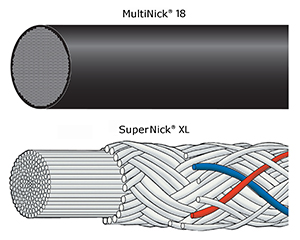|
|

Trends in Stringing Part II: Multifilament Polyurethane
By Steve Crandall
Vice President, Sales & Marketing
Ashaway Racket Strings

With many multifilament nylon strings, like Ashaway's popular SuperNick® XL line, the core and sleeve or wear layer elements remain separate and retain some ability to move relative to one another. The polyurethane resin in Ashaway's new MultiNick® 18 string binds the multifilament sheath and surface into a single unitized matrix. The polyurethane itself becomes a smooth ultra-tough surface that resists abrasion and notching and still retains tension effectively. And while not at all "sticky" or "tacky," this surface has natural adhesive properties that help grip and spin the ball, while the string retains its soft feel and comfortable playability. |
In our last column, we talked about stringing trends among Ashaway sponsored players at the 2017 US Open Squash Championships and the increasing use of Zyex® based strings. In short, nearly 70% of Ashaway sponsored players chose a Zyex-based string over one of our nylon multifilament strings.
It is also true, however, that there were non-Ashaway sponsored players at the Championships. A lot of them, in fact. We don't have hard data on how many players use the various brands of string, but what is clear is that there is still a strong base of multifilament nylon string adherents among the world's top players. This tells us that despite nylon's chief liability - tension loss - it still has properties that make for an excellent squash string. Players like the way it feels and wears. More importantly, there are also some material innovations involving multifilament nylon design that promise to make it an even better squash string.
These material advances involve innovative uses of polyurethane (PU), a polymer resin relatively new to the racquet string world. Most people are probably familiar with the term polyurethane from wood finishes, or "varnish" like Minwax® Polyurethane. But polyurethanes have been around for a long time (it was first formulated in 1937) and are so versatile they have been used in a very wide range of applications. Just a few of these include: rigid foam insulation panels; foam seals and gaskets; wheels and tires for roller coasters, shopping carts, and skateboards; automotive suspension bushings; high performance adhesives; surface coatings and sealants; synthetic fibers; hard-plastic parts; and hoses.
When used with other materials to make racquet string, polyurethane brings toughness and its natural adhesive properties. But utilizing these benefits requires a new type of string design and construction.
More traditional nylon multifilament strings, like Ashaway's SuperNick® XL pictured at the right, include a core of multifilament fibers bound together by a sleeve or wear layer, which adds texture and abrasion resistance to the string. In SuperNick XL, this wear layer is composed of high tenacity nylon multifilament and is tightly braided around the core. In other strings, wear layers contain different materials and can be wound or braided in different manners. But in all of these constructions, the core and wear layers remain separate and can actually move relative to one another, which adds a degree of suppleness to the string.
The polyurethane resin used in Ashaway's new MultiNick® 18 string - also shown at the right - makes it a different animal altogether. Here, the resin penetrates through the entire multifilament bundle or sheath, fusing the fibers into a single matrix. Thus, there is no distinct "core" and no separate wear layer wound onto the string, but the whole matrix acts as a single unit. This adds a great deal of durability to the string, while at the same time allowing it to retain nylon's soft feel and comfortable playability.
Plus, the polyurethane itself becomes a smooth ultra-tough surface, one that resists abrasion and notching, and still retains tension effectively. And while not at all "sticky" or "tacky," this surface has natural adhesive properties that help grip and spin the ball.
The result is multifilament nylon string with superior feel that is designed to add toughness, durability and grip for players who like to really cut and spin the ball.
Ashaway's new MultiNick 18 is our first foray into this new polyurethane resin string technology and we are delighted to be able to compete in this market segment and offer players yet another innovation. No single string can suit all tastes and styles of play. At the same time, technology continues to advance, and you never know when a new string will suit you better than an older one. As manufacturers, our job is to stay on top of new technologies and bring you the very best strings we can. As players, your job - in addition to having fun - is to use equipment that helps you be the best you can be.
ZYEX® is a registered trademark of Victrex Ltd.
This article previously appeared in Squash Magazine.
|